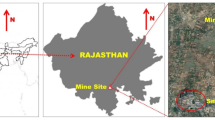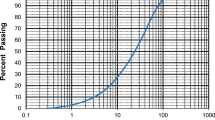Abstract
This paper attempts to portray the status of mine backfill technology for disposal/handling of mill rejects, more specifically the paste backfill (PB) type, a highly relevant aspect in modern day mining industry. To date only a limited number of mines have implemented the PB systems all over the world and in India it is in nascent stage. Characterization of the mill tailings is identified as one of the key elements for design of paste backfill system. The physical, chemical and mechanical characteristics of mill tailings which influence the paste backfill quality and performance are discussed. The driver for this scientific investigation is to explore the applicability of PB system to solid mill tailings of uranium ores, in specific for those which are lean in tenor and ground to very-fine sizes for facilitating adequate liberation of valuable minerals from the host matrix. Some of the outstanding technical issues related to the reliability of PB system design are also discussed emphasizing the need for future advancement of PB technology.





Similar content being viewed by others
References
Scoble M, Klein B, and Dunbar WS, Int J Surf Mining, Reclam Environ 17.2 (2003) 123–135.
Yilmaz E, Belem T, Bussire B, and Benzaazoua M, Cem Concr Compos 33.6 (2011) 702–715.
Bruno B, Can Geotech J 44.9 (2007) 1019–1052.
Belem T, Benzaazoua M, Bussière B, and Dagenais AM, In: Proceedings of the 9th International Conference,Tailings and Mine Waste 2 (2002), p 139–148.
Hassani F P, Hossein M, Newman P, and Bois D, CIM Bull 87.976 (1994) 58–65.
Dorricott M G, and Grice A G, Proc. Green Processing (2002), 265–270.
Yilmaz E, Belem T, and Benzaazoua M, Eng Geol 168 (2014) 23–37.
Yilmaz E, Gospodarka Surowcami Mineralnymi 27 (2011) 89–112.
Hustrulid WA, Hustrulid WA, and Bullock RC, Underground mining methods: Engineering fundamentals and international case studies, SME (2001).
Bieniawski ZT, and Van Heerden WL, Int J Rock Mech Mining Sci Geomech Abstracts 12 (1975)101–113
Brady B H G, and Browm E T, Rock mechanics: for underground mining, 3rd ed, Springer Netherlands (2006).
Belem T, and Benzaazoua M, 3rd Int Conf post-mining (2008), p 6–8.
Fall M, Benzaazoua M, and Ouellet S, In: Proceedings of the 8th International Symposia on Mining with Backfill, Beijing, China (2004), p 193–202.
Landriault D, in 97th Annual General Meeting of CIM Rock Mechanics and Strata Control Session, Halifax, Nova Scoti (1995) 229–238.
Landriault D, in Underground mining methods: engineering fundamentals and international case studies (2001) 601–14.
Sivakugan N, Rankine RM, Rankine KJ, and Rankine KS, J Clean Prod 14.12 (2006) 1168–75.
Craig RF, Craig’s Soil Mechanics.CRC Press (2004) p 464.
Sargeant AL, The Application of Post-Consumer Glass as a Cementing Agent in Mine Backfill,M. Sc.(Eng) Thesis, Queen’s University (2008).
Henderson A, and Revell, M B, Handbook on Mine Fill (eds) Potvin Y, Thomas E H, and Fourie A B, Australian Centre for Geomechanics, Perth, Western Australia (2005), p 11–20
Holubec I, and D’appolonia E, In Evaluation of relative density and its role in geotechnical projects involving cohesionless soils, ASTM International. (1973) p 304–18.
Aubertin M, Bussiere B, and Chapuis RP, Can Geotech J 33.3 (1996) 470–482.
Newman P, White R, and Cadden A, in Proceedings of the 2nd International Conference on Mining and the Environment (2001), p 594–603.
Fall M, Adrien D, Célestin JC, Pokharel M, and Touré M, Miner Eng 22.15 (2009) 1307–1317.
Terzaghi K, Peck R B, and Mesri G, Soil mechanics in engineering practice, John Wiley & Sons (1996).
Aref K, A study of the geotechnical characteristics and liquefaction potential of paste backfill, Ph D Thesis, McGill. Montreal, Quebec (1988).
Potvin Y, Thomas E H, and Fourie A B, Handbook on Mine Fill, Australian Centre for Geomechanics, Perth,Western Australia (2005).
Yilmaz E, Belem T, Benzaazoua M, Kesimal A, and Ercikdi B, Miner Resour Eng. 12.2 (2007) 129–44.
Benzaazoua M, Ouellet J, Servant S, Newman P, and Verburg R. Cem Concr Res 29.5 (1999) 719-725.
Ercikdi B, Kesimal A, Cihangir F, Deveci H, and Alp İ, Cem Concr Compos 31.4 (2009) 268–274
Nicholson R V, Environ Geochemistry Sulphide Mine-Wastes, Short course handbook, Mineral Association of Canada vol 22(1994) p. 163–183.
Ramlochan T, Grabinsky MW, and Hooton R D, in Proceedings of the 11th International Conference,Tailings and Mine Waste (2004), p 293–304.
Mehta P K, and Monteiro PJ, Concrete: Microstructure, Properties, and Materials, vol 3, New York, McGraw-Hill (2005).
Belem T, and Benzaazoua M, Geotech Geol Eng 26.2 (2008) 147-174.
Hewlett P, LEA’S Chemistry of Cement and Concrete, Butterwort Heinemann (2004) p 69, 70,132
Edraki M, Baumgartl T, Manlapig E, Bradshaw D, Franks DM, and Moran CJ, J Clean Prod 84 (2014) 411-420.
Fall M, and Benzaazoua M, In: Proceedings on tailings and mine waste vol 3 (2003), p 12–15.
Sofrá F, and Boger D V, Chem Eng J 86.3 (2002) 319-330
Shook C, McKibben M, and Small M, Can J Chem Eng 68.1 (1990) 17-23.
Kuganathan K, in Proceedings MineTailings 2007. Brisbane, Australia (2007), p 1–13.
ASTM C 143/C 143 M, Annual Book of ASTM Standards, Conshohocken, PA, USA (2012)
Landriault D, in 97th Annual Gen Meet CIM. Rock Mech Strat Control Sess, Halifax, Nov Scotia (1995) 229–238.
Brackebusch FW. Mining Engineering vol 46 (1994), p1175-1178.
Boger D V, in Proceedings of 7th International Symposium on Mining with Backfill: Minefill,vol 98 (1998), p 15–17.
Meggyes T, and Debreczeni Á, L Contam Reclam 14.4 (2006) 815–827
Huynh L, Beattie D A, Fornasiero D, and Ralston J, Miner Eng 19.1 (2006) 28-36
Simon D, Grabinsky MW, and Bawden W, 2011 Pan-Am CGS Geotechnical Conference: 64th Canadian Geotechnical Conference and 14th Pan-American Conference on Soil Mechanics and Geotechnical Engineering (2011), p. 1–8
Boger D V, Scales PJ, and Sofra F, Paste Thick Tailings-A Guid, 2nd ed (eds) Jewel, and Fourie, Australian Centre for Geomechanics, Perth, Australia (2006) p 25.
Belem T, and Benzaazoua M, in Proceedings of the 5th Int Symp on Ground support in Mining and Underground Construction (eds)Villaescusa & Potvin (2004), p. 28–30.
Acknowledgements
The authors are thankful to authorities of UCIL, in specific Engineers of mining department for many useful discussions during this project.
Author information
Authors and Affiliations
Corresponding author
Rights and permissions
About this article
Cite this article
Deb, D., T, S., Dey, G.K. et al. Paste Backfill Technology: Essential Characteristics and Assessment of its Application for Mill Rejects of Uranium Ores. Trans Indian Inst Met 70, 487–495 (2017). https://doi.org/10.1007/s12666-016-0999-0
Received:
Accepted:
Published:
Issue Date:
DOI: https://doi.org/10.1007/s12666-016-0999-0




